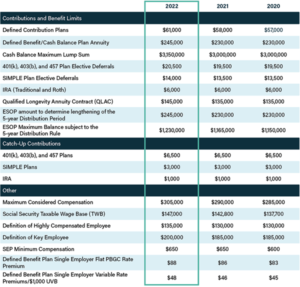On November 4, the IRS released notice 2021-61 which contains technical guidance regarding all of the cost of living adjustments affecting dollar limitations for pension plans and other retirement-related items for tax year 2022 . The IRS highlighted the following changes in their communication IR-2021-216:
The contribution limit for employees who participate in 401(k), 403(b), most 457 plans, and the federal government’s Thrift Savings Plan is increased to $20,500, up from $19,500.
The income ranges for determining eligibility to make deductible contributions to traditional Individual Retirement Arrangements (IRAs), to contribute to Roth IRAs, and to claim the Saver’s Credit all increased for 2022.
Taxpayers can deduct contributions to a traditional IRA if they meet certain conditions. If during the year either the taxpayer or the taxpayer’s spouse was covered by a retirement plan at work, the deduction may be reduced, or phased out, until it is eliminated, depending on filing status and income. (If neither the taxpayer nor the spouse is covered by a retirement plan at work, the phase-outs of the deduction do not apply.) Here are the phase-out ranges for 2022:
- For single taxpayers covered by a workplace retirement plan, the phase-out range is increased to $68,000 to $78,000, up from $66,000 to $76,000.
- For married couples filing jointly, if the spouse making the IRA contribution is covered by a workplace retirement plan, the phase-out range is increased to $109,000 to $129,000, up from $105,000 to $125,000.
- For an IRA contributor who is not covered by a workplace retirement plan and is married to someone who is covered, the phase-out range is increased to $204,000 to $214,000, up from $198,000 to $208,000.
- For a married individual filing a separate return who is covered by a workplace retirement plan, the phase-out range is not subject to an annual cost-of-living adjustment and remains $0 to $10,000.
The income phase-out range for taxpayers making contributions to a Roth IRA is increased to $129,000 to $144,000 for singles and heads of household, up from $125,000 to $140,000. For married couples filing jointly, the income phase-out range is increased to $204,000 to $214,000, up from $198,000 to $208,000. The phase-out range for a married individual filing a separate return who makes contributions to a Roth IRA is not subject to an annual cost-of-living adjustment and remains $0 to $10,000.
The income limit for the Saver’s Credit (also known as the Retirement Savings Contributions Credit) for low- and moderate-income workers is $68,000 for married couples filing jointly, up from $66,000; $51,000 for heads of household, up from $49,500; and $34,000 for singles and married individuals filing separately, up from $33,000.
The amount individuals can contribute to their SIMPLE retirement accounts is increased to $14,000, up from $13,500.



